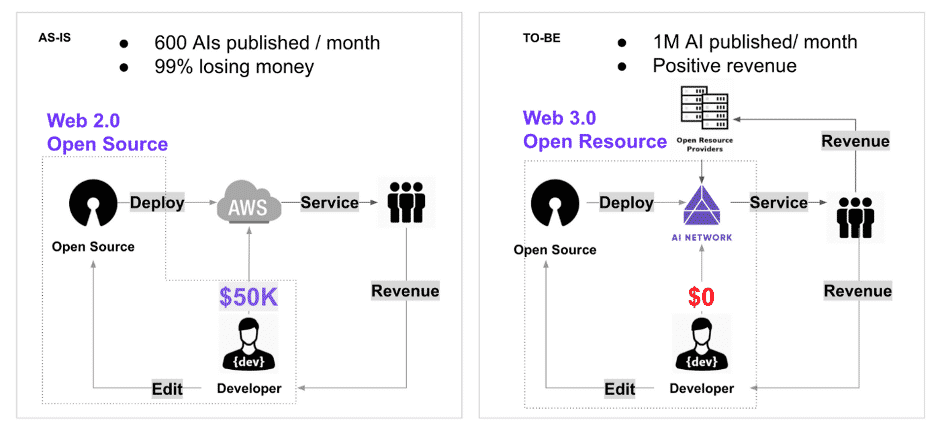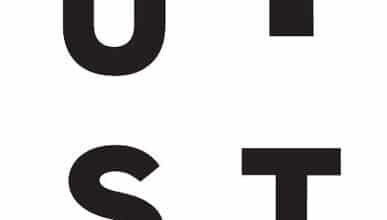With the launch of AI network mainnet, we are one step closer to the internet for AI. AI Network is a blockchain-based, cloud computing network for an open, interoperable ecosystem of AI solutions. No single entity owns AI solutions on the network, but there are contributors, such as computing resource providers and contributors of the source code, who maintain and develop the solutions and get rewards via AIN token.
Intenet, more specifically web 1.0 started with WWW and HTTP. In Web 1.0, information in the world began to be linked through the Internet, a network of computers. This made the information grow explosively. Consequently, giant IT companies such as FANG (Facebook, Amazon, Netflix, Google) appeared. This era is called Web 2.0.
AI Network mainnet, Web 3.0, and blockchain
Web 3.0 starts with the emergence of protocols for linking programs. Examples of the blockchain protocols we know are Bitcoin and Ethereum. These can connect programs. But, programs that move, change and react to the world can also be connected over the Internet!
AI Network mainnet goes a step further and proposes a network of AIs using the network of general programs. Unlike the first-generation and blockchain which can only run very small-sized limited programming languages, AI Network can run AI frameworks (Tensorflow, Pytorch, etc.) using containers. It means millions of open source projects can be hosted and connected on the AI Network blockchain.
Open Source to Open Resource
In the past, AI developers and startups spent an average of $50K cloud costs to operate AI services. In the newly proposed Open Resource ecosystem, AI containers can be managed on the network without a cost burden. Containers on the network are run by resource providers, and resource providers can receive the promised rewards as services on the network generate values.
Unlike Web 2.0 linking only documents, programs could be linked in Web 3.0. In particular, AI Network is a structure that can run programs in any size as long as there is a resource provider on the network. It supports not only smart contracts but also very general programs, large-scale operations that use huge resources, to programs that require a very special computer.
This opens up a world where AI developers no longer have to worry about server costs and can freely unleash their creativity.
All this has been explained in a great way in this video on their YouTube channel.

What makes AI Network mainnet different than existing Blockchains?
- With AI Network, any program can be executed and connected and form a collaborative AI.
Ethereum and other networks support smart contracts, which are special types of code written in programming languages such as Solidity. In AI Network, any type of containerized program can be run on the blockchain.
- Various computing resources support large-scale machine learning
AI Network is a network of not only general PCs, but also computers with GPUs and high-performance machines or clusters that can run large-scale AI. Also, very small, specialized computers, such as the Raspberry Pi, can be registered as Workers running small containers and contribute their resources.
- It supports homomorphic encryption for privacy-preserving machine learning
AI Network uses homomorphic encryption to protect data privacy while also enhancing the reliability of the data. Currently, all data on the public blockchain has to be disclosed, so in order for multiple parties to freely participate in building and use collaborative AI, there must be a way to encrypt the data and perform computations on them.
The internet for AI
Currently, 300 GPUs are connected to the AI Network, and 300 developers and creators are working together. We have established the world’s first AINFT and issued one reference AINFT so far.
With the launch of the mainnet in 2022, We plan to secure 15,000 GPUs to 100,000 developers. 10,000 or more AINFT is aimed to be minted.
The ultimate goal is to build the Internet for AI where all data, code, and models are open source, and the resources that operate them are also managed in the open resource ecosystem with blockchain. Here, all communication will be stored on the blockchain, and AI will grow through interaction with the community. AI Network will connect the world’s largest GPU clusters, AI models, and data pipelines.

By 2022, the aim is to mint 700 million AINs with 15,000 GPUs connected. According to Metcalfe’s law, the market value of AIN is expected to reach $5B when 15,000 nodes are successfully contributed.



